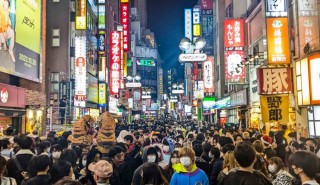Loading
Search
▼ Foreign Tourists In Japan Are Being Charged More Than Locals At Some Restaurants And Attractions
- Category:Tourism
- In short: Popular tourist destinations in Japan are implementing two-tiered pricing systems for locals and inbound tourists.
- Stagnant wages and weakened yen has incentivised locals to take matters into their own hands.
- What's next?: More tourism attractions like the Himeji Castle are considering implementing higher ticket prices for tourists.
As a record number of Australians head to Japan, some restaurants and tourist attractions have started implementing two-tiered pricing systems for visitors and locals.
Japan's weak currency is attracting tourists in droves, but it's pushing up costs for local businesses.
All-you-can-eat seafood restaurant Tamatebako, located in one of Tokyo's busiest districts Shibuya, is one of the restaurants charging different prices for residents of Japan and tourists.
A note in Japanese at the bottom of the eatery's menu says Japanese residents receive a 1,000-yen ($9.50) discount.
"Regular" pricing for the all-you-can-eat and drink seafood buffet is 8,778 yen ($83), while those with proof of residency in Japan can have the same meal for 7,678 yen ($73).
Restaurant owner Shogo Yonemitsu told the ABC the influx of tourists had forced him to employ English-speaking staff who were paid a slightly higher wage.
He said the price difference also took into account the "extra labour of teaching foreigners the right manners at Japanese restaurants".
Imposing the extra costs created by tourists onto locals would be unfair, he said.
"We have also experienced many tourists cancelling at the last minute, which very few Japanese people do," he said.
Weak Japanese yen
Dragged down by Japan's low inflation and interest rates, the yen has lost about a third of its value compared to the US dollar since 2021.
The currency's weakness has made Japan an attractive destination for travellers.
According to the Japan National Tourism Organisation, the number visiting Japan has surpassed pre-pandemic levels of visitors every month since January of this year.
A record 252,900 Australians travelled to Japan between January and March compared to 172,896 the same period in 2019.
That included 82,000 in March, which was almost double the number in March 2019.
However, the weak yen has also made the price of imports such as food higher, forcing restaurants to either increase prices or cop the costs.
Yonemitsu said the Japanese government had failed to provide any support for restaurants to keep up with demand and increasing costs due to the weakening of the yen.
When asked about the reaction from customers Yonemitsu said, "our customers come knowing our pricing system, so it hasn't caused any issues."
Tourist hotspots' two-tiered pricing
It's not just restaurants that are implementing tiered pricing.
UNESCO World Heritage site Himeji Castle in western Japan is considering quadrupling the entry prices for foreign tourists.
The mayor of Himeji city, Hideyasu Kiyomoto, said in a press conference he supported differential pricing.
"Foreign tourists come here once in their lifetime, but locals enjoy this place regularly," he said.
Japan's iconic Mount Fuji introduced a mandatory 2,000 yen ($19) climbing fee in May, but some have called for the fee to be increased for tourists.
Mountaineer Ken Noguchi said the fee was not high enough to combat over tourism.
"Tourists should pay 30,000 yen ($284), while locals pay 10,000 yen ($95)," Noguchi said in a post on X, formerly known as Twitter.
Japanese politicians such as Kenta Izumi also voiced their support for two-tiered pricing.
Stagnant wages
While the weakening of the yen has allowed inbound tourists to be able to spend more in Japan, the country's stagnant wages has meant locals' purchasing power has remained relatively low.
Wages in Japan have barely increased in the past 20 years, with the average minimum wage still only 1,004 yen ($9.52) per hour in 2023, according to the Ministry of Health, Labour and Welfare of Japan.
"The two-tiered pricing system could be a way to keep restaurants accessible for locals instead of being priced out," said Garth Lean, a senior lecturer in tourism and heritage studies at Western Sydney University.
"But it might mean that for tourists it becomes a more expensive experience, and they might feel taken advantage of," said Dr Lean.
The Japanese cabinet has released a white paper on tourism to address the growing concerns about over tourism.
It said the government would support increased efforts to create sustainable solutions to the problem.
The Japan National Tourism Organisation told the ABC that "generally speaking, tourists should pay whatever is deemed an appropriate price during their travels in Japan."
- June 25, 2024
- Comment (0)
- Trackback(0)


